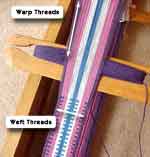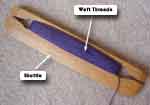The warp is the set of threads that
represent the straight grain of the fabric. When you buy
woven fabric (as opposed to knits) off the bolt, the length
of fabric that you purchase is measured along the warp of
the fabric. In inkle weaving, the warp is the set of threads
that you wrap around the pegs of your loom before any weaving
can be done. In tablet weaving, the warp is the set of threads
that run through the holes in the cards.
 |
Click on the image to the right to see a larger
version of the image in a separate browser window.
The larger image is 40k in size.
|
The weft is the set of threads that run perpendicular
to the warp. When you buy woven fabric off the bolt, the
width of the fabric is measured along the weft. In inkle
and tablet weaving, the weft is the thread you have wrapped
on your shuttle (if you use a shuttle) and is passed back
and forth between the sheds of the warp.
The shed is the space you create in the warp by
the raising or lowering of every other warp thread. The
weft thread is passed through this opening. This becomes
more clear later in this document.
The shuttle is a device that is an optional tool
in weaving. Weaving is much easier with a shuttle,
but you can actually weave without one. It is something
onto which you wind your weft for the ease of passing the
weft through the shed. In inkle weaving, oftentimes the
shuttle doubles as a beater bar.
 |
Click on the image to the right to see a larger
version of the image in a separate browser window.
The larger image is 25k in size.
|
The beater bar or stick is used for beating the
weft threads together to pack them tightly during the weaving
process. Most times this bar is the shuttle but can be
anything with a long, flat surface (such as a credit card
or the back edge of a table knife) preferably with a tapered
edge. The beating of the threads happens in a motion that
is toward you, compressing the weft thread of the row you
have just woven into the previous rows.
The definitions of these terms will become more evident
as you begin the process of weaving. More terms will follow
as needed. If there are terms that haven't been defined
that you think should be added here, please let
me know and I'll add them. |